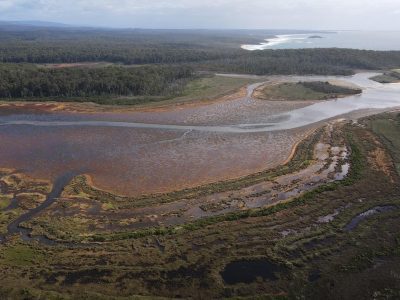Resourceful ‘lucky’ country
There are at last two reasons we can claim to be a “lucky” country – a shared and rich cultural heritage and a unique natural resource inheritance. This endowment from First Nations people and various geological epochs stretching back to the earliest periods of Earth’s history must be better understood and appreciated. Few nations enjoy such riches. Our deep cultural history is incredible and so are our natural resources . Here the focus is on natural resources.
The Proterozoic (2.5 to 1.9 billion years ago) gave us the banded iron formations which formed on the vast continental shelves of this time. Oxygen from the earliest marine microbes created the iron rich seabed sediments which was to become iron ore so important to the nation’s coffers. Tectonic events back then and since have led to mineralisation of rocks across the continent. In the Mesozoic around 200-300 million years ago, organic rich sediments laid down in the sedimentary basins of eastern Australia have been transformed to coal. Oil and gas resources formed in these basins as was that iconic rock, the Hawkesbury Sandstone, the backdrop for Sydney’s magnificent Harbour and old buildings.
If we jump forward to the last 40 million years, we see the further emergence of Australia’s natural resources. Over this period forces of plate tectonics pushed our continent toward its present position, oceans opened up to the south, and rivers spread new soils across vast tracts of country as landscapes revealed their drying character. Unique fauna and flora evolved to be encountered over 60,000 years ago by First Nations people. They adapted to the swings of climate during the Last Glaciation with distinctive cultures capable of managing the array of habitats that changed as climates cooled then warmed.
All this history was interrupted with European settlement. New cultures with different technologies descended on these ancient ecosystems and peoples with dramatic and often disastrous consequences. Howard’s “blemishes” in our historical record are really very grave and need to be understood including ravages to the nation’s soils and waters. Our forefathers failed to provide any rights for Nature in the Constitution although it recognised property interests with limited regulation of property “rights”. Nevertheless our history does offer us accomplishments that also require understanding.
Resourcefulness involves capacity to adapt and innovate. We found ways to utilise our natural resources that today help define the wealth and lifestyles of modem Australia within a democratic federal system. From days of crude sluicing for gold to sophisticated remote-controlled devices used to extract those ancient iron formations, our miners have enriched the nation. Giants of industry secured the future of long-lasting companies, such as Essington Lewis at BHP. These endeavours have been reinforced by stable financial institutions which have also underpinned investment in agriculture. Our combination of deeply weathered soils and those of flooded lands offered opportunities for an array of farming systems. Innovation in agriculture by landowners was supported by government research organisations like CSIRO. Learning to live with distinctive Australian geographic conditions has been and continues to be a challenge especially given variability in rainfall. Mistakes have been made, but patience and determination drive many to find methods to cope and thrive.
Our continent’s geographic position means higher likelihood of extreme climatic events. This will require new ways of living for many in rural and urban areas. But it also offers enhanced opportunities to capture the power behind nature’s energy sources and in the process decarbonise. The sunshine is there to be captured, as is wind. Perhaps in years to come wave and tidal energy will also add to Australia’s capacity to drive new technologies and thereby enhance our comparative advantages in primary and secondary industries. Yes, we are “lucky” with our geologic and other natural resources. They provide us with an incredible inheritance that cannot be squandered. It remains to be seen if private and public sectors together can find ways to capture this legacy as we move into the new climate era.
Bruce Thom
Words by Prof Bruce Thom. Please respect the author’s thoughts and reference appropriately: (c) ACS, 2022. For correspondence about this blog post please email austcoastsoc@gmail.com
#209


 FUTURE EARTH AUSTRALIA: SUSTAINABLE OCEANS AND COASTS NATIONAL STRATEGY 2021-2030
FUTURE EARTH AUSTRALIA: SUSTAINABLE OCEANS AND COASTS NATIONAL STRATEGY 2021-2030